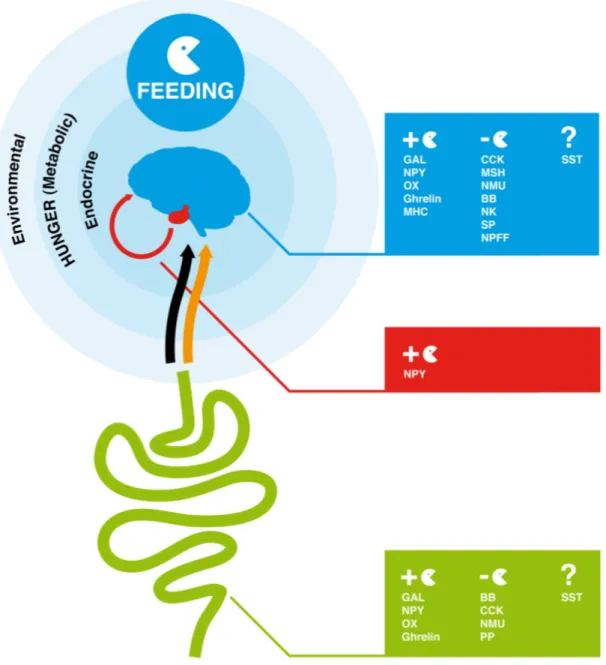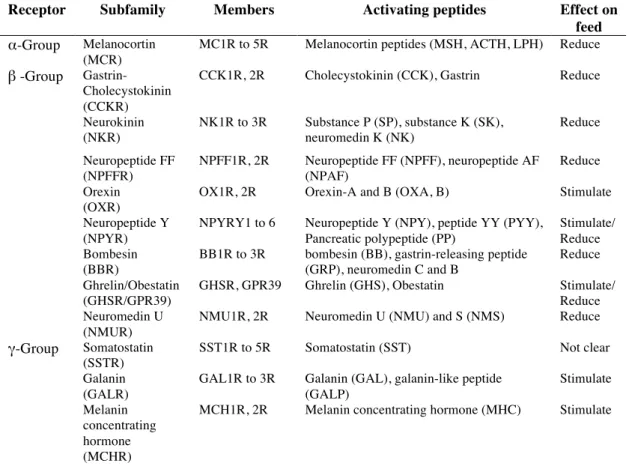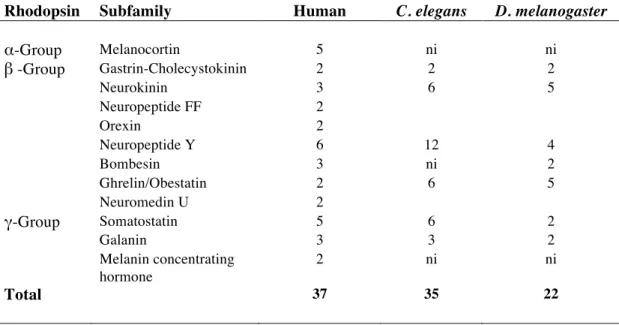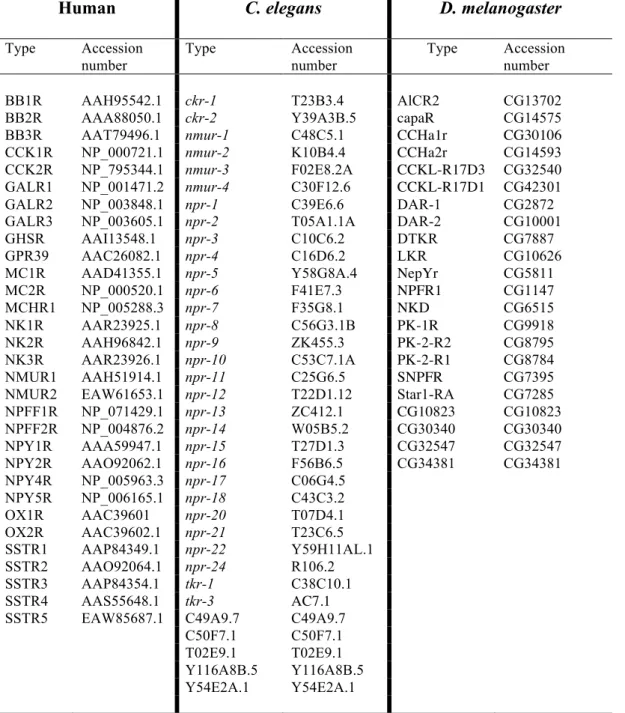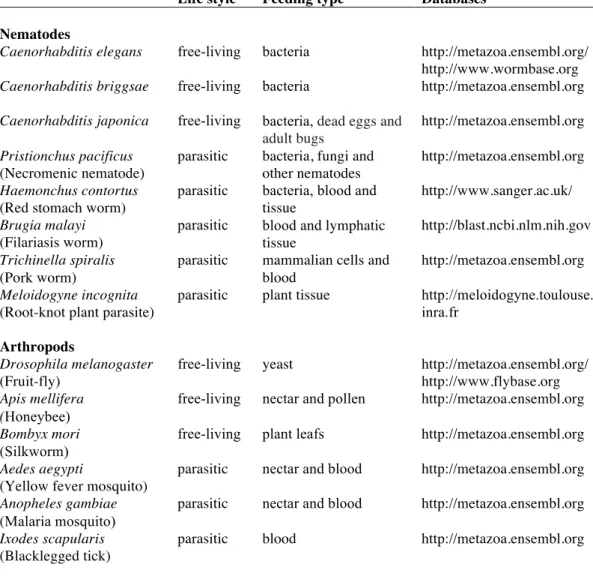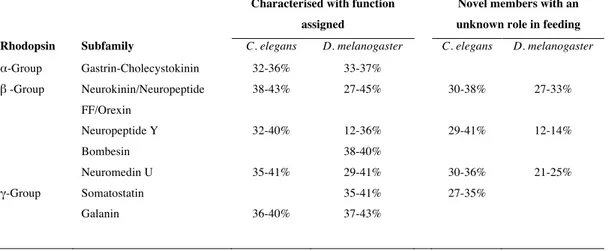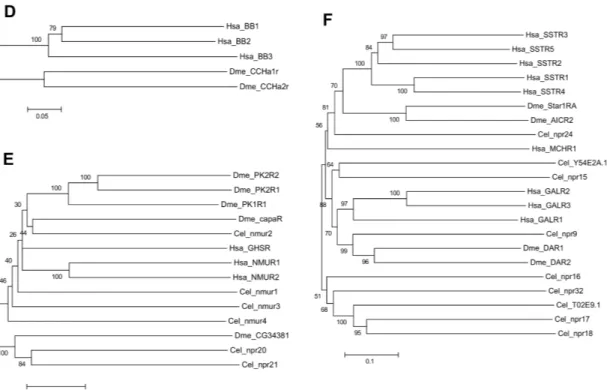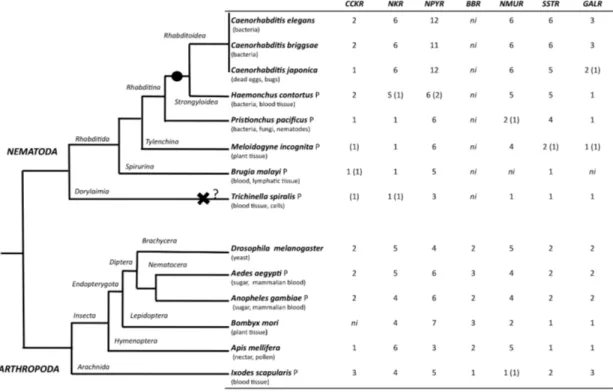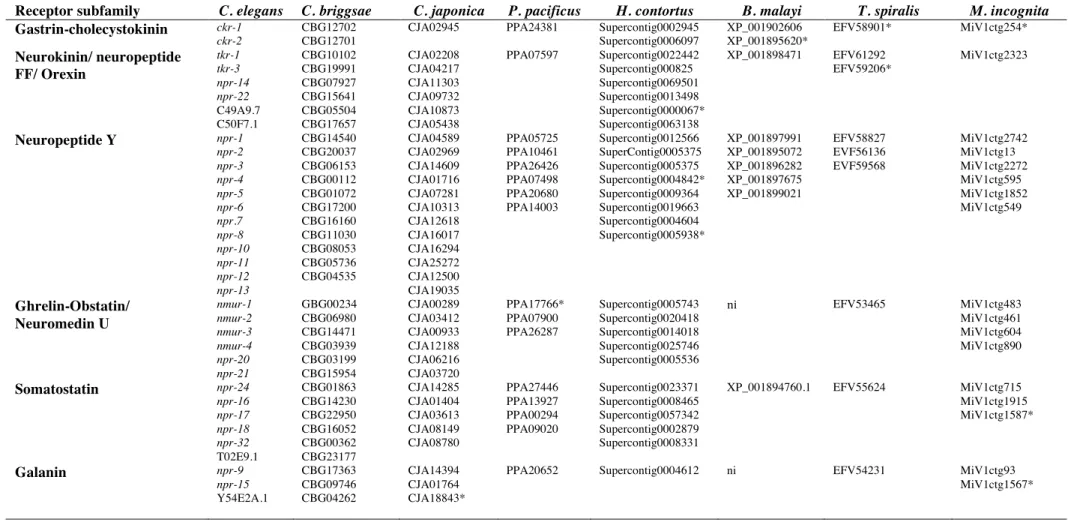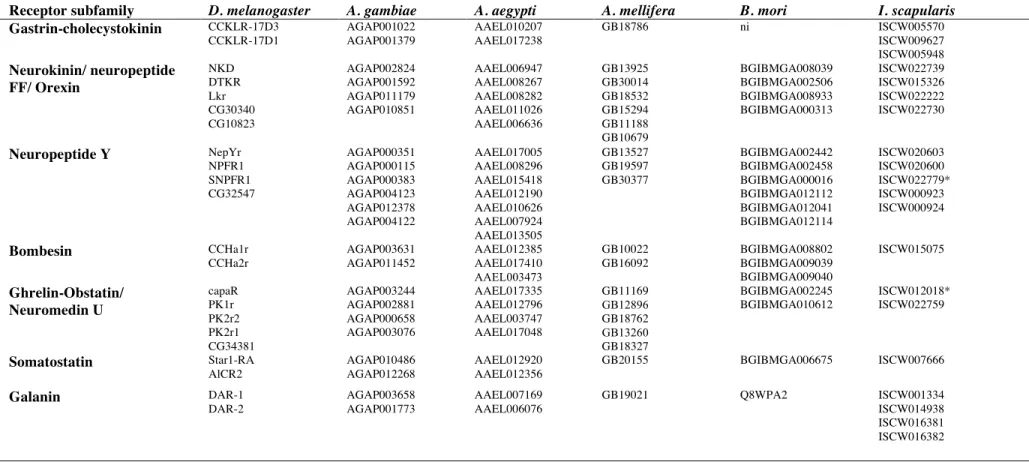IN NEUROENDOCRINE SCIENCE
Feeding and the rhodopsin family G-Protein Coupled Receptors (GPCRs) in
nematodes and arthropods
Joao Carlos dos Reis Cardoso, Rute Castelo Felix, Vera Garcia Fonseca and Deborah Mary Power
Journal Name: Frontiers in Endocrinology
ISSN: 1664-2392
Article type: Review Article
Received on: 28 Aug 2012
Accepted on: 22 Nov 2012
Provisional PDF published on: 22 Nov 2012
Frontiers website link: www.frontiersin.org
Citation: Cardoso JC, Felix RC, Fonseca VG and Power DM(2012) Feeding and the rhodopsin family G-Protein Coupled Receptors (GPCRs) in nematodes and arthropods. 3:157. doi:10.3389/fendo.2012.00157
Article URL: http://www.frontiersin.org/Journal/Abstract.aspx?s=744& name=neuroendocrine%20science&ART_DOI=10.3389 /fendo.2012.00157
(If clicking on the link doesn't work, try copying and pasting it into your browser.)
Copyright statement: © 2012 Cardoso, Felix, Fonseca and Power. This is an open‐access article distributed under the terms of the Creative Commons Attribution License, which permits use, distribution and reproduction in other forums, provided the original authors and source are credited and subject to any copyright notices concerning any third-party graphics etc.
This Provisional PDF corresponds to the article as it appeared upon acceptance, after rigorous peer-review. Fully formatted PDF and full text (HTML) versions will be made available soon.
Review
Feeding and the rhodopsin family G-Protein Coupled
Receptors (GPCRs) in nematodes and arthropods
João C.R. Cardoso
*, Rute C. Félix, Vera G. Fonseca, Deborah M.
Power
Molecular Comparative Endocrinology, Centre of Marine Sciences,
Universidade do Algarve, Faro, Portugal
Running title: Rhodopsin GPCRs evolution in invertebrates
Correspondence: João C.R. Cardoso
Molecular Comparative Endocrinology Centre of Marine Sciences
Universidade do Algarve Campus de Gambelas 8005-139
Faro, Portugal jccardo@ualg.pt
Abstract
In vertebrates, receptors of the rhodopsin G-protein coupled superfamily (GPCRs) play an important role in the regulation of feeding and energy homeostasis and are activated by peptide hormones produced in the brain-gut axis. These peptides regulate appetite and energy expenditure by promoting or inhibiting food intake. Sequence and function homologues of human GPCRs involved in feeding exist in the nematode roundworm, Caenorhabditis elegans (C. elegans) and the arthropod fruit fly,
Drosophila melanogaster (D. melanogaster), suggesting that the mechanisms that
regulate food intake emerged early and have been conserved during metazoan radiation. Nematodes and arthropods are the most diverse and successful animal phyla on Earth. They can survive in a vast diversity of environments and have acquired distinct life styles and feeding strategies. The aim of the present review is to investigate if this diversity has affected the evolution of invertebrate GPCRs. Homologues of the C. elegans and D. melanogaster rhodopsin receptors were characterized in the genome of other nematodes and arthropods and receptor evolution compared. With the exception of bombesin receptors (BBR) that are absent from nematodes, a similar gene complement was found. In arthropods, rhodopsin GPCR evolution is characterized by species-specific gene duplications and deletions and in nematodes by gene expansions in species with a free-living stage and gene deletions in representatives of obligate parasitic taxa. Based upon variation in GPCR gene number and potentially divergent functions within phyla we hypothesize that life style and feeding diversity practiced by nematodes and arthropods was one factor that contributed to rhodopsin GPCR gene evolution. Understanding how the regulation of food intake has evolved in invertebrates will contribute to the development of novel drugs to control nematodes and arthropods and the pests and diseases that use them as vectors.
1. Introduction
Feeding is the process by which food is obtained to provide energy. It must satisfy growth, survival and reproductive requirements and has driven the evolution of specialized feeding behaviors and apparatus in metazoan. Regulation of feeding is a complex mechanism, which involves a combination of physical, chemical and nutritional factors (Neary et al., 2004;Coll et al., 2007;Woods et al., 2008). Food-taking behavior is dependent on environmental signals (odors and taste), hunger signals (metabolic signals) and also endocrine satiety signals that via the blood stream or the vagal afferent terminals act on the hypothalamus, brain stem or afferent autonomic nerves to modulate feeding response (Figure 1) (Konturek et al., 2004;Stanley et al., 2005;Chaudhri et al., 2006;Woods et al., 2006;Woods et al., 2008). In mammals, psychological factors such as mood (emotions) and food reward have also been shown to affect eating behaviour (Christensen, 1993;Berridge, 1996). In vertebrates, a group of small regulatory peptides that are produced by the brain-gut axis play a major role in the endocrine regulation of feeding and control of energy homeostasis (Figure 1) (Coll et al., 2007;Chaudhri et al., 2008). These peptide hormones are divided into two groups, those that stimulate appetite (orexigenic peptides) and induce food intake and those that cause loss of appetite (anorexigenic peptides) and reduce food consumption and increase energy expenditure (Ahima and Osei, 2001;Wilding, 2002;Suzuki et al., 2010). The action of such peptides involves the activation of specific G-protein coupled receptors (GPCRs), which undergo conformational changes and promote the activation of intracellular signalling mechanisms that ultimately lead to a cellular response (Table 1) (Marinissen and Gutkind, 2001;Xu et al., 2004;Fredriksson and Schioth, 2005).
The involvement of GPCRs in the regulation of vertebrate feeding and appetite is well recognized (Shioda et al., 2008). Much less is known about their homologues and cognate activating peptides in non-vertebrates. However, comparative sequence approaches and functional studies suggest that the involvement of GPCRs in metazoa feeding behaviour emerged early and has been maintained during the species radiation (Brody and Cravchik, 2000;Hewes and Taghert, 2001;Fredriksson and Schioth, 2005;Teng et al., 2008). GPCRs have emerged via gene or genome duplication events followed by selection of the gene duplicates. Understanding the origin of GPCRs represents a valuable tool for the characterization of basic physiological functions that have been maintained during evolution. The present review takes a comparative approach and targets rhodopsin GPCR subfamily members in the model species, C.
elegans (a nematode) and D. melanogaster (a arthropod) that are sequence and
function homologues of vertebrate GPCRs implicated in feeding regulation. To enrich the data and provide insight into how divergent life style and feeding strategies may have shaped receptor evolution in invertebrates the sequence of the target GPCRs were identified in other nematodes and arthropods with available genome data.
Figure 1. Overview of endocrine factors that regulate feeding behavior in the human brain-gut axis. In humans and other vertebrates, feeding is regulated by signals from the environment (odor and taste), hunger (metabolic signals) and endocrine signals produced by the gut and brain. The orange arrow represents the blood connection between gut and brain and the black arrow the nervous connection via the vagal afferent terminals through which peptides produced by the gut modulate the feeding response in the brain. GAL, NPY, OX, Ghrelin and MCH are orexigenic peptides and promote appetite and feeding. CCK, MSH, NMU, BB, NK, SP, NPFF are anorexigenic. The role of SST peptides in feeding is unclear. The full peptide names are indicated in Table 1.
Table 1. Rhodopsin GPCR family members and activating peptides that regulate food intake in mammals. Receptor subfamily members, activating peptides and their effect on feed (stimulation or reduction) are indicated. For references please consult the text.
2. The vertebrate GPCRs superfamily and their role in feeding
GPCRs are one of the largest groups of receptors present in cells. Based upon their structure and sequence similarity five distinct superfamilies have been defined in human: Glutamate (G), Rhodopsin (R), Adhesion (A), Frizzled (F) and Secretin (S) and are collectively known as GRAFS (Fredriksson and Schioth, 2005) (Figure 2). GPCRs are characterized by a signature motif of seven conserved transmembrane spanning helix domains (TM) in vertebrates and non-vertebrates. Receptor activation is mediated by the extracellular N-terminal domain and also by TM and extracellular loops (receptor core domain) that interact with diverse types of molecules. The cellular response is provoked by the receptor C-terminal domain which activates a series of intracellular signaling cascades via the G-protein coupled pathway complex (Bockaert and Pin, 1999;Marinissen and Gutkind, 2001). Other molecular mechanisms such assembly of receptor heterodimers and allosteric receptor-receptor interactions in the cell membrane are also involved in GPCR regulation, activation and signaling (Prinster et al., 2005;Langmead and Christopoulos, 2006;Fuxe et al., 2012).
GPCRs are ubiquitous and involved in many different physiological functions. The glutamate receptors are involved in synaptic plasticity and participate in numerous
Receptor Subfamily Members Activating peptides Effect on
feed α-Group Melanocortin
(MCR)
MC1R to 5R Melanocortin peptides (MSH, ACTH, LPH) Reduce β -Group
Gastrin-Cholecystokinin (CCKR)
CCK1R, 2R Cholecystokinin (CCK), Gastrin Reduce
Neurokinin (NKR) NK1R to 3R Substance P (SP), substance K (SK), neuromedin K (NK) Reduce Neuropeptide FF (NPFFR) NPFF1R, 2R Neuropeptide FF (NPFF), neuropeptide AF (NPAF) Reduce Orexin (OXR)
OX1R, 2R Orexin-A and B (OXA, B) Stimulate Neuropeptide Y
(NPYR)
NPYRY1 to 6 Neuropeptide Y (NPY), peptide YY (PYY), Pancreatic polypeptide (PP)
Stimulate/ Reduce Bombesin
(BBR)
BB1R to 3R bombesin (BB), gastrin-releasing peptide (GRP), neuromedin C and B
Reduce Ghrelin/Obestatin
(GHSR/GPR39)
GHSR, GPR39 Ghrelin (GHS), Obestatin Stimulate/ Reduce Neuromedin U
(NMUR)
NMU1R, 2R Neuromedin U (NMU) and S (NMS) Reduce γ-Group Somatostatin
(SSTR)
SST1R to 5R Somatostatin (SST) Not clear
Galanin (GALR)
GAL1R to 3R Galanin (GAL), galanin-like peptide (GALP) Stimulate Melanin concentrating hormone (MCHR)
functions in the central nervous system (CNS) (Niswender and Conn, 2010). Rhodopsin receptors include receptors for hormones, neurotransmitters and photons and they are involved in taste, smell and also regulate metabolism, reproduction and neural function (Simoni et al., 1997;Murdoch and Finn, 2000;Gaillard et al., 2004;Waldhoer et al., 2004). Adhesion receptors participate in cell adhesion, signaling and immune function (Bjarnadottir et al., 2007;Yona et al., 2008). Frizzled receptors are involved in the Wnt signalling pathway and in the control of cell proliferation and embryogenesis (van Amerongen and Nusse, 2009;Schulte, 2010). In contrast to other GPCRs, secretin family members are only activated by peptide hormones and they are implicated in brain-gut functions, calcium homeostasis and in the stress response (McDermott and Kidd, 1987;Harmar, 2001;Bale and Vale, 2004;Moody et al., 2011). Due to their conserved structure and presence in many phyla, GPCRs are suggested to have a common evolutionary origin and to have arisen via gene/genome duplication early in the species radiation (Krishnan et al., 2012). With the exception of the glutamate family members, they are proposed to share a common ancestor with the cAMP receptors of primitive eukaryote species (Nordstrom et al., 2011).
Figure 2. Stylised phylogenetic tree showing the relationship between human GRAFS. The number of human representatives identified within each superfamily is indicated within brackets (Fredriksson et al., 2003). Rhodopsin family members (which are represented by the blue branch) are the most numerous and their members are classified into four main sub-branches (α, β, γ and δ). Human receptors, which are activated by peptides and have a role in feeding regulation, are members of the rhodopsin and secretin families.
In humans, more than 700 GPCR genes are predicted and a large proportion are orphans with unknown function (Figure 2). The rhodopsin family (a.k.a family A or class 1 GPCRs) comprise the most diverse receptor group and in humans they account for more than 80% of GPCRs and include members that are involved in regulation of feeding (Joost and Methner, 2002;Fredriksson et al., 2003). Rhodopsin family members possess a short N-terminal domain and are characterised by the presence of several conserved amino acid motifs such as N-S-x-x-N-P-x-x-Y within TM7 and the DRY (D(E)-R-Y(F)) motif between TM3 and intracellular loop (IL) 2 (Schioth and Fredriksson, 2005;Suwa et al., 2011). Based upon sequence similarity the human rhodopsin receptors are sub classified into four main groups (α, β, γ and δ) (Figure 2) (Fredriksson et al., 2003). The α-group contains clusters for the prostaglandin, amine, opsin, melatonin, melanocortin, endothelial, cannabinoid and adenosine binding receptors. Members of the β-group include a subfamily of receptors for which known ligands are peptides such as orexin (OX), neuropeptide FF (NPFF), neurokinin (NK), gastrin-cholecystokinin (CCK), neuropeptide Y (NPY), endothelin-related (EDN), bombesin and related peptides (BB), neurotensin (NTS), ghrelin and obstatin, neuromedin (NMU), thyrotropin releasing hormone (TRH), arginine vasopressin (AVP), gonadotropin-releasing hormone (GNRH) and oxytocin (OXT). The γ group includes receptors for somatostatin (SST), opioids, galanin (GAL), melanin-concentrating hormone (MCH) and chemokine peptides. The δ group contains the olfactory receptors (highly diverse > 400 members) as well as the glycoprotein, purine and the MAS-related receptor clusters. In humans, eleven members of the rhodopsin family, which are activated by peptide hormones, play an important role in feed intake and stimulate or reduce food consumption (Table 1). The majority of these receptors are β group members and their role in the regulation of feed intake in mammals will now be briefly considered.
Receptors for melatonin (MT), gastrin-cholecystokinin (CCK), neurokinin (NK), neuropeptide FF (NPFF), bombesin and related peptides (BB) and neuromedin (NMU) have an inhibitory role in feed intake in vertebrates. Melanocortin receptors (MCR) are activated by melanocortin (ACTH, MSH and lipotropin) peptides and administration of receptor agonists significantly reduces food consumption in rats (Irani and Haskell-Luevano, 2005). In addition mutant MC3R mice have increased fat mass (Coll et al., 2007) and ablation of the MC4R gene results in severe obesity (Coll et al., 2004;Millington, 2007). In rats, mutations of CCK1R are associated with obesity (Kopin et al., 1999) and peripheral administration of an NK1R antagonist leads to reduced weight gain after a high-fat diet (Karagiannides et al., 2011). Injection of NPFF provokes anorexia in mice and induces satiety (Murase et al., 1996;Bechtold and Luckman, 2006) (Bechtold and Luckman, 2007;Cline et al., 2009). BB peptides also mediate satiety (Hampton et al., 1998;Yamada et al., 2002;Gonzalez et al., 2008) and knockout BB2R mice have increased body weight (Ladenheim et al.,
2002) and BB3R-deficient mice exhibit a mild obesity phenotype and increased food intake (Ohki-Hamazaki et al., 1997). Mice lacking the NMU gene are hyperphagic and have increased adiposity and obesity and amino acid variants in NMU are associated with human obesity (Brighton et al., 2004;Hainerova et al., 2006).
In contrast, orexin (OXs), neuropeptide Y (NPYs), galanin (GAL) and melanin concentrating hormone (MCH) receptors are activated by orexigenic peptides which stimulate feeding (Sakurai, 1999;Branchek et al., 2000;Chamorro et al., 2002;Lecklin et al., 2002;Lang et al., 2007;Wong et al., 2011). Administration of orexin-A and B stimulates food consumption in a dose-dependent manner (Sakurai et al., 1998;Matteri, 2001). NPY is one of the most potent orexigenic factors and NPY-induced feeding is markedly reduced in Y1-knockout mice and NPY Y1 receptor deficient mice lack appetite (Mercer et al., 2011;Pjetri et al., 2012). GAL1R-KO mice display increased food intake and body weight gain in response to an acute 3-day high-fat challenge (Zorrilla et al., 2007). MCH is a hypothalamic appetite-stimulating peptide that is high in obese mice (Kawauchi, 2006;Coll et al., 2007) and deletions in MCH1R confer resistance to diet-induced obesity (DIO) and MCH1R antagonists are effective in reducing body weight (Chung et al., 2011).
The role of SSTR and their activating peptides in vertebrates is unclear. In rats SSTR can stimulate or inhibit appetite although peptide injections in chickens have an orexigenic effect (Tachibana et al., 2009). In addition receptors for ghrelin-obestatin have opposing effects on feeding and ghrelin is associated with hunger scores and plasma ghrelin levels increase during fasting and decrease after food intake (Rocha-Sousa et al., 2010). Treatment of rats with obestatin suppresses food intake and decreases body-weight gain (Zhang et al., 2005).
Other GPCR families activated by peptide hormones may also play a role in food intake and include members of the secretin receptor family: Pituitary Adenylate-Cyclase Activating Peptide/Vasoactive Intestinal Peptide (PACR/VIPR) (Morley et al., 1992;Chance et al., 1995); Glucagon and related peptide (GCGR/GLPR) (McMahon and Wellman, 1997; 1998;Tang-Christensen et al., 2001;Woods et al., 2006).); Calcitonin (CTR) (Riediger et al., 2004) and Corticotrophin Releasing Factor (CRFR) receptors (Heinrichs and Richard, 1999) (Bradbury et al., 2000;Richard et al., 2002). However, the secretin receptor family will not be considered in the present review.
3. The invertebrate GPCRs superfamily
Invertebrates are one of the most diverse animal groups and they represent more than 95% of the species on Earth. Protostomia comprise the majority of the species identified and are of both ecological and economic importance as they are involved in the nutrient cycle, plant fertilization and include agricultural pests and vectors of human disease, such as malaria and sleeping sickness. The divergence of Protostomes from Deuterostomes occurred more than 700 million years ago (MYA) and their success is associated with adaptations to a variety of ecological niches and modifications in their feeding habits that allow them to live, survive and reproduce in many different environments. Invertebrates can be herbivores (eating plant tissue,
nectar and pollen), carnivores (feeding on other invertebrates as well as larger animals), parasites (living on plant and animals) and detritus feeders (eating dead animal and plants). Surprisingly few studies exist about the regulation of feed intake in invertebrates, despite its importance for their success and this is also a neglected target for alternative control strategies. The genome of several invertebrates has been sequenced and in the metazoan Ensembl genome database (www.ensemblgenomes.org) 48 invertebrate genomes are available. Comparative molecular studies represent an invaluable mechanism to better understand invertebrate
biology and to characterize endocrine factors associated with feeding.
Homologues of the vertebrate GPCR repertoire have been described in many invertebrates and representatives of the five distinct human GRAFS families are proposed to have emerged before the split of nematodes from the chordate lineage (Table 2) (Fredriksson and Schioth, 2005). The model organisms, the nematode roundworm C. elegans and the fruit fly D. melanogaster are the most studied Prostostomes. Their genomes have been completely sequenced and are fully annotated and a vast range of functional resources exists and numerous GPCRs have been characterized (Consortium, 1998;Adams et al., 2000;Keating et al., 2003). In the roundworm, GPCRs account for approximately 5% of the genome (there are more than 1000) and the chemoreceptor genes, which are involved in chemoreception of environmental stimuli are unique in nematodes and are also the most abundant and diverse (Schioth and Fredriksson, 2005;Robertson and Thomas, 2006;Nagarathnam et al., 2012). In the fruit fly, approximately 200 GPCRs (1% of the genome) are predicted and the gustatory/taste receptors (Montell, 2009) are specific to insects although a quarter share sequence homology with vertebrate neurohormone receptors (Keating et al., 2003;Fredriksson and Schioth, 2005;Hauser et al., 2006;Nagarathnam et al., 2012). Recently GPCRs were also characterised in the genome of two Platyhelminthes, the blood fluke Schistosoma mansoni and the planarian Schmidtea
mediterranea and a similar gene repertoire to vertebrates has been characterised. A
platyhelminth-specific rhodopsin subfamily (PROF1) and a planarian-specific Adhesion-like family (PARF1) have been identified suggesting lineage-specific GPCRs evolved in invertebrates (Suwa et al., 2011;Zamanian et al., 2011).
Comparison of the neuroendocrine GPCR complement in the fruit fly and the honey bee Apis mellifera (A. mellifera) revealed that a similar gene complement is present (Hauser et al., 2006). In the malaria vector, the mosquito Anopheles gambiae (A.
gambiae) genome, a total of 276 GPCRs are predicted and approximately 30
correspond to putative neuropeptide receptors (Hill et al., 2002). With the exception of C. elegans, very little is known about GPCRs in other nematodes despite availability of molecular data in public databases. The activating molecules for the roundworm and fruit fly GPCRs in common with other organisms are in general neurohormones (biogenic amines, protein hormones and neuropeptides) and they play a central role in the control of behavior, reproduction, development, feeding and many other physiological processes. This suggests that GPCR signaling has been conserved during evolution and that neuropeptide signaling plays a key role in both Proto and Deuterostomes (Grimmelikhuijzen and Hauser, 2012).
Table 2. Gene number and receptor subfamilies of the human rhodopsin GPCRs involved in feeding and the sequence homologues identified in C. elegans and D.
melanogaster. The total number of receptor genes in human, C. elegans and D. melanogaster is indicated. In C. elegans and D. melanogaster the homologues of the
human Neurokinin/Neuropeptide FF/Orexin receptors and Ghrelin-Obestatin/! Neuromedin U receptors were grouped due to their high sequence relatedness (Hewes and Taghert, 2001). ni - not identified.
The present review provides a general overview of the evolution of the rhodopsin GPCR members that are implicated in feeding regulation. It will start by identifying and describing sequence homologues of human rhodopsin GPCRs in the model invertebrate organisms C. elegans and D. melanogaster followed by the characterization of their homologues in other nematodes and arthropods with distinctive feeding habits and life styles (Table 4). The C. elegans and D.
melanogaster rhodopsin GPCR repertoire was obtained from published data and to
enrich and confirm the dataset it was complemented with appropriate database searches using the human homologues (Table 3). A total of 35 rhodopsin GPCRs are present in C. elegans and 22 in D. melanogaster genomes (Table 2) and a conserved role in feeding regulation has been demonstrated.
Rhodopsin Subfamily Human C. elegans D. melanogaster
α-Group Melanocortin 5 ni ni β -Group Gastrin-Cholecystokinin 2 2 2 Neurokinin 3 6 5 Neuropeptide FF 2 Orexin 2 Neuropeptide Y 6 12 4 Bombesin 3 ni 2 Ghrelin/Obestatin 2 6 5 Neuromedin U 2 γ-Group Somatostatin 5 6 2 Galanin 3 3 2 Melanin concentrating hormone 2 ni ni Total 37 35 22
Table 3. The human, C. elegans and D. melanogaster rhodopsin GPCRs used for comparative sequence analysis and their accession numbers.
Human C. elegans D. melanogaster
Type Accession number Type Accession number Type Accession number BB1R AAH95542.1 ckr-1 T23B3.4 AlCR2 CG13702
BB2R AAA88050.1 ckr-2 Y39A3B.5 capaR CG14575
BB3R AAT79496.1 nmur-1 C48C5.1 CCHa1r CG30106
CCK1R NP_000721.1 nmur-2 K10B4.4 CCHa2r CG14593
CCK2R NP_795344.1 nmur-3 F02E8.2A CCKL-R17D3 CG32540
GALR1 NP_001471.2 nmur-4 C30F12.6 CCKL-R17D1 CG42301
GALR2 NP_003848.1 npr-1 C39E6.6 DAR-1 CG2872
GALR3 NP_003605.1 npr-2 T05A1.1A DAR-2 CG10001
GHSR AAI13548.1 npr-3 C10C6.2 DTKR CG7887
GPR39 AAC26082.1 npr-4 C16D6.2 LKR CG10626
MC1R AAD41355.1 npr-5 Y58G8A.4 NepYr CG5811
MC2R NP_000520.1 npr-6 F41E7.3 NPFR1 CG1147 MCHR1 NP_005288.3 npr-7 F35G8.1 NKD CG6515 NK1R AAR23925.1 npr-8 C56G3.1B PK-1R CG9918 NK2R AAH96842.1 npr-9 ZK455.3 PK-2-R2 CG8795 NK3R AAR23926.1 npr-10 C53C7.1A PK-2-R1 CG8784 NMUR1 AAH51914.1 npr-11 C25G6.5 SNPFR CG7395
NMUR2 EAW61653.1 npr-12 T22D1.12 Star1-RA CG7285
NPFF1R NP_071429.1 npr-13 ZC412.1 CG10823 CG10823 NPFF2R NP_004876.2 npr-14 W05B5.2 CG30340 CG30340 NPY1R AAA59947.1 npr-15 T27D1.3 CG32547 CG32547 NPY2R AAO92062.1 npr-16 F56B6.5 CG34381 CG34381 NPY4R NP_005963.3 npr-17 C06G4.5 NPY5R NP_006165.1 npr-18 C43C3.2 OX1R AAC39601 npr-20 T07D4.1 OX2R AAC39602.1 npr-21 T23C6.5 SSTR1 AAP84349.1 npr-22 Y59H11AL.1 SSTR2 AAO92064.1 npr-24 R106.2 SSTR3 AAP84354.1 tkr-1 C38C10.1 SSTR4 AAS55648.1 tkr-3 AC7.1
SSTR5 EAW85687.1 C49A9.7 C49A9.7
C50F7.1 C50F7.1 T02E9.1 T02E9.1 Y116A8B.5 Y116A8B.5 Y54E2A.1 Y54E2A.1 ! !
4. Feeding in nematodes and arthropods !
Feeding in invertebrates in common with other animals involves a complex combination of physical, chemical and nutritional factors (Chapman and De Boer, 1995). Taste and smell are important for feeding behavior and provide the CNS with information on quality and quantity of food and feeding behavior occurs mainly in
response to both nutrient and nutritional storage status. Once feeding has been initiated and food ingested, the alimentary canal and its associated glands triturate, lubricate, store, digest and absorb the food material and excrete and expel unwanted remains (Audsley and Weaver, 2009).
The Nematoda is a highly diverse, complex and specialized group of metazoans, about 30,000 species are currently known and many are renowned parasites (15%) and have specialized life cycles that depend on their host to survive and reproduce. Their success is associated with a protective, impermeable cuticle and by the diversity of the pharynx and feeding mechanisms (Coghlan, 2005). The shape and presence or absence of teeth, lancets, stylets or other structures in the mouth reflects their distinct feeding methods. The majority of nematodes are free-living and inhabit soil and water and feed on microorganisms (bacteria, fungi, algae) and organic debris. The parasites feed on animal and plant tissues and some on vertebrate blood.
The Arthropoda represents the most diverse animal phyla and comprises over 80% of the species identified and the Insecta class is the most specious with approximately 920,000 species. Four main classes of feeding habits are recognized: plant feeders, predators (feed on aphids and mites), scavengers (feeding on dead and decaying organic matter) and parasites (of other insects and vertebrates), some of which are haematophagous. Within each of these classes, various types of feeding can be found such as biting and chewing on leaves or animal tissue and sucking from plant or animal cells or tissues. Despite this unique ability to use almost any organic substrate, most insect species restrict themselves to a particular category of food (Posnien et al., 2010) and feed primarily on a fluid diet (Prakash and Steele, 2010). The variety of feeding habits in arthropods is the result of anatomical and physiological adaptations to distinct food sources (Chapman and De Boer, 1995). The alimentary canal is composed of specialized regions that vary according to feeding habit and life stage. The organisms selected for analysis of rhodospin GPCRs potentially involved in invertebrate feeding are members of different nematode and arthropod lineages. The specific life style and feeding habits of the invertebrates included in the analysis are indicated in Table 4.
Table 4. Nematodes and arthropods used to analyse the rhodopsin GPCRs.
Information about life style, feeding type and the database interrogated is indicated.
5. Homologues of the vertebrate Rhodopsin family GPCRs implicated in feeding and appetite regulation in non-vertebrates
The following section describes the evolution and function of rhodopsin family members in nematodes and arthropods. It will start with an overview of those described in C. elegans and D. melanogaster involved in or candidates for feed intake regulation (Table 2 and Table 5). Expression data when available from wormbase and flybase is included to provide insight into receptor function. It is followed by a section in which receptor evolution in invertebrates is discussed including homologues from non-model nematode and arthropod species.
In general, no putative melatonin peptide receptors (MCR) or melanin concentrating hormone receptor (MCHR) homologues have been described or were identified in the
Life style Feeding type Databases
Nematodes
Caenorhabditis elegans free-living bacteria http://metazoa.ensembl.org/ http://www.wormbase.org
Caenorhabditis briggsae free-living bacteria http://metazoa.ensembl.org
Caenorhabditis japonica free-living bacteria, dead eggs and adult bugs
http://metazoa.ensembl.org
Pristionchus pacificus
(Necromenic nematode)
parasitic bacteria, fungi and other nematodes
http://metazoa.ensembl.org
Haemonchus contortus
(Red stomach worm)
parasitic bacteria, blood and tissue
http://www.sanger.ac.uk/
Brugia malayi
(Filariasis worm)
parasitic blood and lymphatic tissue
http://blast.ncbi.nlm.nih.gov
Trichinella spiralis
(Pork worm)
parasitic mammalian cells and blood
http://metazoa.ensembl.org
Meloidogyne incognita
(Root-knot plant parasite)
parasitic plant tissue http://meloidogyne.toulouse. inra.fr
Arthropods
Drosophila melanogaster
(Fruit-fly)
free-living yeast http://metazoa.ensembl.org/ http://www.flybase.org
Apis mellifera (Honeybee)
free-living nectar and pollen http://metazoa.ensembl.org
Bombyx mori
(Silkworm)
free-living plant leafs http://metazoa.ensembl.org
Aedes aegypti
(Yellow fever mosquito)
parasitic nectar and blood http://metazoa.ensembl.org
Anopheles gambiae
(Malaria mosquito)
parasitic nectar and blood http://metazoa.ensembl.org
Ixodes scapularis
(Blacklegged tick)
present study in any of the selected nematodes or arthropods (Figure 3). In addition, in nematodes no homologue of the vertebrate and fruit fly bombesin receptors seem to exist (Table 2). Duplicates of the human receptor genes were identified in the genomes of nearly all target species and phylogenetic analysis suggests specific gene duplication/deletions occurred within the nematode and arthropod lineages.
Table 5. An overview of the amino acid sequence similarity of the main subfamilies of C. elegans and D. melanogaster rhodopsin GPCRs and their human homologues. Percentage of sequence similarity was calculated in the GeneDoc programme (http://www.nr.bsc.org/gfx/genedoc/). The maximum and minimum sequence similarity of receptor subgroups between invertebrate and human homologues is indicated.
5.1. The Rhodopsin GPCRs in C. elegans and D. melanogaster genomes 5.1.1. Characterised and functionally assigned subfamily members Gastrin-Cholecystokinin receptor subfamily
In the genomes of C. elegans and D. melanogaster two putative Gastrin-CCK-like receptor homologues of the human members have been reported (Figure 3A) (Keating et al., 2003;Janssen et al., 2008). In C. elegans, ckr-1 and ckr-2 have been described and functionally characterized. The ckr-1 is expressed in the nerve ring and functional RNAi knockdown studies reveal that the loss of receptor activity provokes fat accumulation (McKay et al., 2007). However, if the receptors are ablated there is no apparent effect on feeding regulation but instead embryonic lethality and reduced brood size is observed (McKay et al., 2007). The neuropeptide nlp-12 is the ligand of nematode ckr-2 and the peptide-receptor pair shares conserved biological activity with regards to fat storage with the human homologue (Janssen et al., 2008). A cognate peptide for nematode ckr-1 is yet to be identified.
In D. melanogaster the two existent CCK-like receptors were designated CCKL-R17D3 (DSKR1) and CCKL-R17D1 (Kubiak et al., 2002). They are mainly expressed in the CNS and are activated by Drosophila sulfakinin (DSK) (Nichols et al., 1988), which is a structurally and functionally related peptide to the vertebrate CCK
Characterised with function assigned
Novel members with an unknown role in feeding Rhodopsin Subfamily C. elegans D. melanogaster C. elegans D. melanogaster
α-Group Gastrin-Cholecystokinin 32-36% 33-37% β -Group Neurokinin/Neuropeptide FF/Orexin 38-43% 27-45% 30-38% 27-33% Neuropeptide Y 32-40% 12-36% 29-41% 12-14% Bombesin 38-40% Neuromedin U 35-41% 29-41% 30-36% 21-25% γ-Group Somatostatin 35-41% 27-35% Galanin 36-40% 37-43%
(Audsley and Weaver, 2009). Their role in feeding regulation has not yet been demonstrated in Drosophila but in other arthropods the homologue receptor stimulation by SK causes gut emptying and satiety (Nichols, 2007). Injections of SK peptides significantly reduce the meal size in locusts (Schistocerca gregaria) (Wei et al., 2000) and cockroach (Blattella germanica) (Maestro et al., 2001), carbohydrate feeding in the blowfly (Phormia regina) and inhibit female horse flies from blood feeding (Downer et al., 2007).
Neurokinin/ neuropeptide FF/ Orexin receptor subfamily
In C. elegans two putative neurokinin (a.k.a. tachykinins) receptors tkr-1 and tkr-3 have been described (Keating et al., 2003;Greenwood et al., 2005). In D.
melanogaster three neurokinin-like receptors have been reported: the neurokinin
receptor (NKD), the tachykinin receptor (DTKR) (Li et al., 1991;Monnier et al., 1992;Rosay et al., 1995;Poels et al., 2009) and the leucokinin receptor (LKR) (Radford et al., 2002). Phylogenetic analysis of the invertebrate receptors suggests that they arose from an ancestral Neurokinin/ neuropeptide FF/ Orexin-like receptor gene by species-specific duplication events prior to the Proto- Deuterostome divergence (Figure 3B(Hewes and Taghert, 2001). Characterization of the C. elegans
tkr-1 revealed expression is restricted to the socket cells (specialized nerve-accessory
cells that act as an interface between the sensillum and hypodermis) and RNAi functional screens and the Nile Red fat assay revealed that this gene affects fat metabolism and fat droplet morphology and the pattern of fat deposition (Ashrafi et al., 2003). Knock down nematodes have a substantially lower fat content suggesting that this receptor is a key lipid storage regulator. Tkr-3 RNAi studies caused mild sluggishness and slowed locomotion in nematodes (Keating et al., 2003), which may be related to modifications in the nervous system. Tkr-3 is also present in the intestine but no role has yet been assigned in feeding and metabolism.
The D. melanogaster NKD and DTK receptors are expressed in the head of both larvae and adults and are activated by Drosophila tachykinin (DTK1–6) peptides, which are derived from the drosotachykinin (Dtk) gene (Birse et al., 2006;Poels et al., 2007) and also by substance P which is involved in the regulation of food intake and energy homeostasis in vertebrates (Birse et al., 2006;Poels et al., 2007). Knock down of DTKR in D. melanogaster modulated expression in both fed and starved flies of insulin-like peptides, which play a major role in the regulation of carbohydrates and lipid metabolism (Poels et al., 2009;Birse et al., 2011).
Neuropeptide Y receptor subfamily
In C. elegans four putative NPY-like receptors (npr-1, npr-2, npr-5 and npr-11) that share conserved sequence with the vertebrate NPYRs have been isolated and function characterized (de Bono and Bargmann, 1998;Keating et al., 2003;Kubiak et al., 2008;Cohen et al., 2009). Three NPY-like receptors have also been reported in D. melanogaster, these are the NepYr receptor and two neuropeptide F (NPF) receptors, the NPFR1 and the short NPFR (SNPFR) (Figure 3C). The NPF peptide occurs as a long (NPF) and short (sNPF) isoform in arthropods (De Loof et al., 2001) and is the homologue of vertebrate neuropeptide Y (NPY) (Li et al., 1992;de Jong-Brink et al., 2001).
Figure 3. Phylogenetic relationship of the Human (Hsa) rhodopsin GPCRs involved in feeding with the nematode C. elegans (Cel) and arthropod D. melanogaster (Dme) sequence homologues. Trees were constructed using the neighbour joining method with 1000 bootstrap replicates (uniform rate among sites, pairwise deletion using the p-distance substitution model) built in the Mega5.1 programme. Receptors were classified into six distinct subfamilies: A) Gastrin-Cholecystokinin receptors; B) Neurokinin/ neuropeptide FF/ Orexin receptors, C) Neuropeptide Y receptors, D) Bombesin receptors, E) Ghrelin/Obstatin and Neuromedin U receptors and F) Somatostatin and galanin receptors. Accession numbers are described in Table 3.
In C. elegans, the nematode npr-1 was the first receptor found to influence social feeding behavior and is predominantly expressed in the nervous system (de Bono and Bargmann, 1998). This receptor is activated by flp-21 peptide (Rogers et al., 2003) and ablation of the peptide does not cause silencing of npr-1 functions, suggesting that it can be activated by other molecules. In fact, flp-18 peptide also activates npr-1 and this peptide is also the ligand of npr-5, which is involved, in chemosensory response, foraging behavior and fat metabolism (Rogers et al., 2003). Nematode npr-5 is expressed in the head, neck, and body muscles and knock down and gene mutation studies revealed that in common with npr-2 it is associated with intestinal fat storage regulation (Keating et al., 2003;Cohen et al., 2009), dauer formation and other food-dependent decisions (Cohen et al., 2009). The npr-11 has a role in reproduction and sensory dynamics of the olfactory system (Chalasani et al., 2010) but no role in feeding has yet been demonstrated (Chalasani et al., 2010).
The fruit fly NepYr and NPF receptors are expressed in the D. melanogaster CNS and NepYr is also present in the gut. NepYr is activated by 1 and dRYamide-2, which has a C-terminal sequence similar to vertebrate NPY family peptides and in flies dRYamide- suppresses feeding motivation (Ida et al., 2011). NPF and its receptors also modulate feeding behavior in D. melanogaster (Wu et al., 2003;Garczynski et al., 2005) and they promote feeding in larvae (Wu et al., 2003) and influence the effect of food deprivation in adult flies (Wu et al., 2003;Lingo et al., 2007). In other arthropods their functions have also been described and NPFR is involved in hindgut contraction in the bloodsucking bug (Rhodnius prolixus) (Gonzalez and Orchard, 2009) and in ovarian maturation in locusts (Schoofs et al., 2001). In D. melanogaster sNPF is involved in the control of food intake and in the regulation of body size (Lee et al., 2004). Studies in mutant fruit flies over expressing sNPF peptide exhibit increased food intake and produce bigger and heavier flies, whereas sNPF loss-of-function mutants exhibit suppressed food intake (Lee et al., 2004). Gene expression studies with the red fire ant (Solenopsis invicta Buren) revealed SNPFR in brain is down-regulated during starvation (Chen and Pietrantonio, 2006) and expression of long NPF and its receptor in the malaria mosquito (A. gambiae) appear to be dependent on the insect nutritional status (Garczynski et al., 2005).
Bombesin receptor subfamily
Homologues of the vertebrate bombesin receptors have not been reported in nematodes and were not identified in the present study. Members of this family are only present in D. melanogaster and they correspond to the Allatostatin-type B receptors (Stay, 2000). In D. melanogaster, two bombesin-like receptors have been isolated and function characterized: CCHamide-1r (CCHa-1r) (Johnson et al., 2003) and CCHamide-2r (CCHa-2r) (Johnson et al., 2003;Hauser et al., 2008) (Figure 3D).
In insects the function of the arthropod bombesin receptor is still poorly explored as a specific ligand has only recently been identified. CCHa-2r expression was detected in
D. melanogaster brain and in the CNS and midgut of B. mori (Roller et al., 2008).
Functional analysis reveals the receptors are activated by the peptides CCHamide-1 or CCHamide-2 that have been shown to suppress feeding activity in the cockroach,
Blattella germanica (Audsley and Weaver, 2009).
Ghrelin-Obestatin/Neuromedin U receptor subfamily
In C. elegans four nmur-like receptors: nmur-1, nmur-2, nmur-3 and nmur-4 have been described. In D. melanogaster the capaR and three pyrokinin receptors PK-1R, PK-2-R1 and PK-2-R2 are the homologues of vertebrate NMURs (Iversen et al., 2002;Park et al., 2002) (Figure 3E). The nematode nmur-1 is suggested to be involved in the sensory system and with processing information from specific food cues, which enables selection of different food types (Maier et al., 2010). C. elegans nmur-2 was also shown with its ligand peptide (derived from the nlp-44 precursor gene) to be involved in the regulation of food intake (Lindemans et al., 2009). To date no functional studies involving nmur-3 and nmur-4 have been reported although nmur-4 is expressed in the pharynx and intestine suggesting it may have a role in feeding, and this remains to be explored.
The D. melanogaster capaR is mainly expressed in the Malpighian tubules and it is involved in the increase of fluid transport and diuresis and no direct role in feeding has yet been attributed (Terhzaz et al., 2012). CapaR is activated by two neuropeptides, capa-1 and -2 that are encoded by the capability gene and have antidiurectic actions in insects (Coast and Garside, 2005;Paluzzi et al., 2010) (Pollock et al., 2004). The capability gene also encodes the pyrokinin-1 (PK1) peptide that is a specific activator of PK1R. PK2R1and PK2R2 are activated by pyrokinin-2 (PK2) and Hug-γ that are derived from the hugin (hug) prepropeptide (Cazzamali et al., 2005).
Phylogenetic analysis of the pyrokinin receptors suggests that they share common ancestry and that PK2R1 and R2 are the result of a recent duplication in the fly genome. The pyrokinin peptides are involved in rhythmic motor activity in arthropods (Saideman et al., 2007) and receptors are expressed in the abdomen (carcass) and nervous tissue and involvement in modulation of feeding behavior has been suggested. Overexpression of the hugin gene was found to suppress feeding in
Drosophila, while blockage of the synaptic activity of hugin neurons caused the
opposite effect (Meng et al., 2002;Melcher and Pankratz, 2005).
Somatostatin receptor subfamily
A homologue of human SSTR in the C. elegans genome was predicted in the 1990’s (Wilson et al., 1994). Characterization of the deduced protein revealed that the signature motif of the vertebrate SSTR was missing in TM7, suggesting that the receptor is probably activated by other ligands. Since no other homologue of vertebrate SSTR has been reported, the function of the putative SSTR-like receptors in nematodes remains to be explored. In arthropods, Allatostatin type-C receptors are the homologues of the vertebrate somastostatin receptors and in D. melanogaster, two receptors star1-RA and AlCR2 were described (Kreienkamp et al., 2002;Mayoral et al., 2010) (Figure 3F).
The D. melanogaster star1-RA and AlCR2 receptors are detected in the CNS and they are activated by allatostatin-C peptides, which are potent modulators of hormone synthesis (Aguilar et al., 2003;Hergarden et al., 2012). These peptides inhibit or stimulate the corpora allata to synthesize juvenile hormone, which is an important regulator of development and reproduction in insects and may indirectly influence feeding behavior (Audsley and Weaver, 2009;Nassel and Winther, 2010).
Galanin receptor subfamily
In C. elegans and D. melanogaster a sequence and function homologue of vertebrate GALR has been described (Figure 3F). The C. elegans GALR-like receptor, npr-9 in common with the vertebrate homologue may be involved in food foraging and lipid storage (Bendena et al., 2008). The npr-9 is expressed in specific neurons around the posterior pharyngeal bulb and C. elegans receptor mutants are characterized by impaired food-related roaming behavior and accumulate intestinal fat as a result of fat ingestion and reduced energy expenditure (Lang et al., 2007;Bendena et al., 2008). Peptides involved in the activation of npr-9 have not been isolated, although nlp-5 and
nlp-6, are candidate allatostatin-like peptides that in insects activate the GAL-like
In arthropods, the Allatostatin type-A receptors are homologues of the vertebrate GALRs (Birgul et al., 1999). Two receptors have been described in D. melanogaster, DAR-1 (a.k.a. AlstR) and DAR-2 (Birgul et al., 1999;Lenz et al., 2000)(Figure 3F). AlstR is expressed in D. melanogaster head and CNS while DAR-2 is expressed in the gut suggesting they may have divergent functions. The receptors are activated by FGLamide neuropeptides (Pratt et al., 1991;Woodhead et al., 1994) that in arthropods inhibit food intake (Audsley and Weaver, 2009). Genetic epistasis assays in D.
melanogaster indicate that FGLamide neuron activation inhibits or limits
starvation-induced changes in feeding behavior (Hergarden et al., 2012).
5.1.2. Novel subfamily members with an unknown role in feeding regulation Neurokinin/ neuropeptide FF/ Orexin-like receptor subfamily
In C. elegans four additional NKRs members may exist: npr-14, npr-22 and the genes C49A9.7 and C50F7.1 (Keating et al., 2003)). In D. melanogaster the SIFamide receptor and the gene CG10823 (Hewes and Taghert, 2001) also seem to be novel receptor members (Table 5, Figure 3B). In the phylogenetic tree, the C. elegans gene C49A9.7 clusters with tkr-1 suggesting they may be duplicates and the nematode
npr-14 and C50F7.1 genes group with the fruit fly CG30340 and SIFamide receptor genes
suggesting that they may have emerged from the same gene prior to the nematode-arthropod divergence. Functional studies of these receptors are scarce but those that exist indicate that the C. elegans MVRFamide neuropeptides but not tachykinin-like peptides activate the npr-22 receptor (Mertens et al., 2006). The function of D.
melanogaster CG30340 gene, which is present in low abundance in the digestive and
nervous system and of SIFamide receptors are unknown (Jorgensen et al., 2006).
Neuropeptide Y-like receptor subfamily
In C. elegans at least 8 putative novel NPYR gene members are predicted: 3,
npr-4, npr-6, npr-7, npr-8, npr-10, npr-12 and npr-13 and all remain to be validated and
functionally characterised (Keating et al., 2003) (Figure 3C). The receptors share between 30-40% amino acid sequence similarity with their human counterparts (Table 5) and are approximately 20% identical to the C. elegans homologues with a characterized function. The high sequence similarity and phylogenetic relationship between npr-5 and npr-13 (43%), npr-4 and npr-10 (50%) and npr-11 and npr-12 (44%) suggests that they may have arisen as a result of a recent duplication event in the nematode genome. These receptors are expressed in nervous tissue and intestine and their function is incompletely described and a specific role in feeding has not been demonstrated (Keating et al., 2003;Styer et al., 2008). In the D. melanogaster genome a putative novel insect NPY-like gene of unknown function (CG32547) may also exist (Hewes and Taghert, 2001) and seems to be expressed in the CNS (Figure 3C). The CG32547 gene shares less than 14% similarity with the human NPYR members (Table 5) and with the other insect family members, although this is probably due to its atypical size of 1008 amino acids, which makes family annotation ambiguous.
Ghrelin-Obestatin/Neuromedin U receptor subfamily
Two putative additional C. elegans nmur-like receptor genes the npr-20 and npr-21 were retrieved in the present study (Figure 3E). They share 30-36% amino acid sequence similarity with human homologues and are probably duplicates (Table 5).
Expression of npr-21 in C. elegans occurs in nerves of the head, tail and ventral nerve cord and also in the posterior intestine suggesting that it may have a role in brain-gut function associated with feeding regulation. Similarly in D. melanogaster a putative member of this family was also retrieved, the gene CG34381 (Table 5) and it clusters with nematode npr-20 and npr-21 suggesting that it may have shared common ancestry (Hewes and Taghert, 2001). Expression of the CG34381 gene occurred in the fruit fly head but so far no functional studies have been reported.
Somatostatin receptor subfamily
In the C. elegans genome at least eight putative SST-like receptor genes are predicted:
npr-15, npr-16, npr-17, npr-18, npr-24, npr-32 and the Y54E2A.1 (Vashlishan et al.,
2008) and T02E9.1 genes (Keating et al., 2003) (Figure 3F). No additional putative SST-like receptors were identified or have been reported for D. melanogaster. Characterization of the nematode putative SST-like receptors revealed the C. elegans members share between 27-35% amino acid sequence similarity with the human SSTRs and that the npr-24 gene is the most closely related to the insect and human homologues suggesting that they may share a common ancestry (Table 5). Comparisons of the putative SSTR in C. elegans revealed they are highly divergent suggesting that after their emergence from an ancestral gene they underwent considerable change. Nematode npr-17 is most similar to npr-18 and to the T02E9.1 gene with which it shares 23% sequence identity and the three receptors tend to cluster with npr-16 and npr-32 suggesting they emerged in the nematode lineage.
The physiological role of the nematode SST-like receptors is poorly characterized but a role in metabolism and feeding behavior is probable. RNAi knockdown studies of
npr-16, found to be expressed in head/tail neurons and the ventral nerve cord,
increased fat deposition (Ashrafi et al., 2003). Ligand binding studies revealed that the peptide nlp-3 activates the receptor npr-17, which seems to be involved in food aversion and has a role in serotonergic modulation via ASH sensory neurons to modulate nematode behavior in response to an external stimuli (Harris et al., 2010). Deletion of the T02E9.1 gene resulted in an uncoordinated phenotype and nematodes moved slowly and with an increase in circular movement, although feeding was apparently unaffected (Keating et al., 2003). The function of npr-15, npr-18, npr-24,
npr-32 and Y54E2A.1 remain to be explored.
5.2. Evolution of Rhodopsin GPCR homologues in invertebrates
The evolution of the rhodopsin GPCRs in invertebrates was established by identifying homologues in different nematode and arthropod lineages of the receptors present in
C. elegans and D. melanogaster. In general, the invertebrate GPCRs with a
documented role in feeding or that are sequence homologues of mammalian seem to have evolved differently in nematodes and arthropods. A similar gene complement to that identified in C. elegans and D. melanogaster was identified in non-model nematodes and arthropods, respectively (Figure 4). Nematodes of the superfamily Rhabditoidea generally have more genes than other nematodes. Gene duplicates in C.
elegans and C. brigssae are more abundant than in arthropods (Lynch and Conery,
2000;Cutter et al., 2009) and a higher number of homologues of the human NPYRs and SSTRs occur in nematodes when compared to arthropods (Figure 4). In
arthropods, species-specific gene duplications exist rather than a conserved gene homologue complement suggesting that, despite their common ancestry, GPCRs have had distinct evolutionary trajectories in the different lineages.
Figure 4. Distribution of rhodopsin subfamily members in nematodes and arthropods. The phylogenetic relationship of the species analysed is represented on the right and their feeding habits are indicated. The black circle indicates a putative gene duplication event in the nematode radiation and the black cross potential gene deletion in the T. spiralis genome. Genes that were identified based upon sequence similarity but that were not considered for phylogenetic analysis are indicated within brackets “( )”; ni- GPCR member not identified and P represent parasitic nematode and arthropod. The evolutionary relationship within nematodes and arthropods was obtained from (Consortium, 2006;Sommer and Streit, 2011).
A striking observation is the absence in nematodes of homologues of the arthropod bombesin receptors (BBR) (Figure 4, Table 5). The reason for the loss of BBR in nematodes is unknown and their function and any link to feeding regulation remains to be established. In vertebrates, bombesin and its receptors are involved in smooth muscle contraction, exocrine and endocrine secretion in the gut, pancreas, and pituitary and they also have a central role in food intake and energy homeostasis (Sano et al., 2004;Gonzalez et al., 2008). Three receptors have been isolated in humans and a similar number exist in arthropods and they share a common ancestry. A similar number of gastrin-CCK, NKR, NMUR and GALR subfamily members were characterized in nematodes and arthropods (Figure 4). Two putative gastrin-CCK receptors were identified in invertebrates and in humans two gastrin-gastrin-CCK receptors also exist suggesting that the evolution of the members of this family has
been highly conserved. However, phylogenetic analysis suggests that the duplication, which delivered the two gene copies, was not common to all the species and occurred independently within each lineage. The two ckr that are present in nematodes resulted from a lineage specific duplication and homologues of the two C. elegans genes were identified in most nematode genomes analyzed (Figure 5A). In arthropods, a different situation exists and the two D. melanogaster genes are very similar and seem to have resulted from a species-specific duplication event (Figure 6A). Similarly in the blacklegged tick (I. scapularis) three putative gastrin-CCK receptors were also identified. In contrast, no putative homologues were identified in the plant feeding arthropod, the silkworm B. mori, even though they had a similar gene complement to other arthropods. It remains to be established if the absence of this receptor in B. mori is a consequence of its incomplete genome assembly (Xia et al., 2004) or represents an adaptation relative to feeding regulation.
Members of the NKR, NMUR and GALR subfamilies have also evolved via lineage specific and species-specific duplication events. In nematodes, a similar number of NKR, NMUR and GALR receptors exist in H. contortus and in the three representatives of the Caernohabitis genus analyzed (Figure 5B, D, E). In contrast, few genes of these families have been identified in other nematode taxa and a single NKR subfamily member was retrieved from P. pacificus, M. incognita, B. malayi and
T. spiralis. In arthropods, gene duplication of the D. melanogaster LKR receptor
homologues was identified in the mosquito A. aegypti and also in I. scapularies in which four putative receptors exist (Figure 6B). In addition, in the honeybee (A.
mellifera) three putative homologues of the fruit fly DTKR receptors were also
identified. In contrast, no homologues of D. melanogaster NKD were detected in the honeybee and A. aegypti genomes. Within the NMUR family (Figure 6E), the D.
melanogaster PK2Rs emerged as a consequence of a species-specific duplication
event and two putative capaR were also identified in the honeybee, but only a single member was found in I. scapulars. In contrast, duplication of GALR occurred in the I.
scapulars genome and four putative receptors were identified while other arthropods
contained a single homologue of D. melanogaster DAR1 and DAR2 genes (Figure 6F).
Table 6. Accession numbers of the C. elegans homologues in C. briggsae, C. japonica, P. pacificus, H. contortus, B. malayi, T. spiralis and M.
incognita. * indicates sequences not used in the phylogenetic analysis due to poor sequence or non identification of TM domains. ni: indicates
gene not identified.
Receptor subfamily C. elegans C. briggsae C. japonica P. pacificus H. contortus B. malayi T. spiralis M. incognita
Gastrin-cholecystokinin ckr-1! ckr-2!
CBG12702! CBG12701!
CJA02945 PPA24381 Supercontig0002945 Supercontig0006097! XP_001902606 XP_001895620*! EFV58901* MiV1ctg254*! Neurokinin/ neuropeptide FF/ Orexin tkr-1 tkr-3 npr-14! npr-22 C49A9.7 C50F7.1 CBG10102 CBG19991! CBG07927 CBG15641 CBG05504 CBG17657! CJA02208 CJA04217 CJA11303 CJA09732 CJA10873 CJA05438 PPA07597 Supercontig0022442 Supercontig000825 Supercontig0069501 Supercontig0013498 Supercontig0000067* Supercontig0063138 XP_001898471 EFV61292 EFV59206* MiV1ctg2323 Neuropeptide Y npr-1 npr-2 npr-3 npr-4 npr-5 npr-6 npr.7 npr-8 npr-10 npr-11 npr-12 npr-13 CBG14540 CBG20037 CBG06153 CBG00112 CBG01072 CBG17200 CBG16160 CBG11030 CBG08053 CBG05736 CBG04535 CJA04589 CJA02969 CJA14609 CJA01716 CJA07281 CJA10313 CJA12618 CJA16017 CJA16294 CJA25272 CJA12500 CJA19035 PPA05725 PPA10461 PPA26426 PPA07498 PPA20680 PPA14003 Supercontig0012566 SuperContig0005375 Supercontig0005375 Supercontig0004842* Supercontig0009364 Supercontig0019663 Supercontig0004604 Supercontig0005938* XP_001897991 XP_001895072 XP_001896282 XP_001897675 XP_001899021 EFV58827 EVF56136 EVF59568 MiV1ctg2742 MiV1ctg13 MiV1ctg2272 MiV1ctg595 MiV1ctg1852 MiV1ctg549 Ghrelin-Obstatin/ Neuromedin U nmur-1! nmur-2! nmur-3! nmur-4! npr-20! npr-21 GBG00234 CBG06980 CBG14471 CBG03939 CBG03199 CBG15954 CJA00289 CJA03412 CJA00933 CJA12188 CJA06216 CJA03720 PPA17766* PPA07900 PPA26287 Supercontig0005743 Supercontig0020418 Supercontig0014018 Supercontig0025746 Supercontig0005536! ni! EFV53465 MiV1ctg483 MiV1ctg461 MiV1ctg604 MiV1ctg890! Somatostatin npr-24 npr-16 npr-17 npr-18 npr-32 T02E9.1 CBG01863 CBG14230 CBG22950 CBG16052 CBG00362 CBG23177 CJA14285 CJA01404 CJA03613 CJA08149 CJA08780 PPA27446 PPA13927 PPA00294 PPA09020 Supercontig0023371 Supercontig0008465 Supercontig0057342 Supercontig0002879 Supercontig0008331 XP_001894760.1 EFV55624 MiV1ctg715 MiV1ctg1915 MiV1ctg1587* Galanin npr-9 npr-15! Y54E2A.1 CBG17363 CBG09746 CBG04262 CJA14394 CJA01764 CJA18843*
PPA20652 Supercontig0004612 ni EFV54231 MiV1ctg93
Table 7. Accession numbers of the D. melanogaster homologues in A. gambiae, A. aegypti, A. mellifera, B. mori and I. scapularis. * indicates sequences not used in the phylogenetic analysis due to poor sequence or non identification of TM domains. ni: indicates gene not identified.
Receptor subfamily D. melanogaster A. gambiae A. aegypti A. mellifera B. mori I. scapularis
Gastrin-cholecystokinin CCKLR-17D3 CCKLR-17D1 AGAP001022! AGAP001379! AAEL010207! AAEL017238! GB18786! ni! ISCW005570! ISCW009627! ISCW005948! Neurokinin/ neuropeptide FF/ Orexin NKD DTKR Lkr CG30340 CG10823 AGAP002824 AGAP001592 AGAP011179 AGAP010851 AAEL006947 AAEL008267 AAEL008282 AAEL011026 AAEL006636 GB13925 GB30014! GB18532 GB15294 GB11188 GB10679 BGIBMGA008039 BGIBMGA002506 BGIBMGA008933 BGIBMGA000313 ISCW022739 ISCW015326 ISCW022222 ISCW022730 Neuropeptide Y NepYr NPFR1 SNPFR1 CG32547 AGAP000351 AGAP000115 AGAP000383 AGAP004123 AGAP012378 AGAP004122 AAEL017005 AAEL008296 AAEL015418 AAEL012190 AAEL010626 AAEL007924 AAEL013505 GB13527 GB19597 GB30377 BGIBMGA002442 BGIBMGA002458 BGIBMGA000016 BGIBMGA012112 BGIBMGA012041 BGIBMGA012114 ISCW020603 ISCW020600 ISCW022779* ISCW000923 ISCW000924 Bombesin CCHa1r CCHa2r AGAP003631 AGAP011452 AAEL012385 AAEL017410 AAEL003473 GB10022 GB16092 BGIBMGA008802 BGIBMGA009039 BGIBMGA009040 ISCW015075 Ghrelin-Obstatin/ Neuromedin U capaR PK1r PK2r2 PK2r1 CG34381 AGAP003244 AGAP002881 AGAP000658 AGAP003076 AAEL017335 AAEL012796 AAEL003747 AAEL017048 GB11169 GB12896 GB18762 GB13260 GB18327 BGIBMGA002245 BGIBMGA010612 ISCW012018* ISCW022759 Somatostatin Star1-RA AlCR2 AGAP010486 AGAP012268 AAEL012920 AAEL012356 GB20155 BGIBMGA006675 ISCW007666 Galanin DAR-1 DAR-2 AGAP003658 AGAP001773 AAEL007169 AAEL006076 GB19021 Q8WPA2 ISCW001334 ISCW014938 ISCW016381 ISCW016382
Figure 5. Phylogenetic analysis of the nematode rhodopsin GPCRs. A) Gastrin-cholecystokinin receptors; B) Neurokinin/neuropeptide FF/Orexin receptors, C) Neuropeptide Y receptors, D) Ghrelin-Obstatin/Neuromedin U receptors and E) Somatostatin and galanin receptors. The C.elegans (Cel) receptors are annotated in bold. C. briggsae (Cbr), C. japonica (Cja), P. pacificus (Ppa) H. contortus (Hco) B.
malayi (Bma), T. spiralis (Tsp) and M. incognita (Min). Accession numbers of the
sequences used are indicated. Trees were constructed using the sequence alignment displayed in Supplementary Figure 1 using the methodology described in Figure 3.
The complete genome sequence of some of the species used in this study are not yet available, nonetheless gene representatives identified in the selected nematodes and arthropods provides a clear idea of the GPCR evolution in invertebrates. The majority of the C. elegans sequence homologues were identified in the target species and an increase in gene number seems to have occurred in Rhabditoidea and Strongyloidea (Abad et al., 2008;Dieterich et al., 2008;Mitreva et al., 2011). The exception was B.
malayi in which representatives of NMUR and GALR were not identified possibly
because of its incomplete genome assembly (Ghedin et al., 2007). The absence of the majority of the C. elegans receptor homologues in parasitic nematode genomes and the higher number of genes present in H. contortus and in other representatives of the
Caernohabitis genus is curious. A general comparison of the gene content of T. spirallis with C. elegans revealed that the parasitic nematode genome contains fewer
genes (15,808 compared to 20,060 and 19,507 in C. elegans and C. briggsae) and we hypothesize that gene absence is a consequence of the selective pressures provoked by the host on which they live and depend for survival (Mitreva et al., 2011;Sommer and Streit, 2011). The genome of P. pacificus is predicted to contain a higher gene
number than C. elegans and suggests that a specific GPCR gene expansion occurred in the nematode lineage after their divergence (Dieterich et al., 2008;Sommer and Streit, 2011). Comparisons between T. spirallis and the other blood feeding parasitic nematode H. contortus revealed that the latter has a higher GPCR gene number than
T. spirallis. One explanation may be related to their life cycles and while both
nematodes need blood to survive T. spirallis is an obligate parasite, while H.
contortus has a non-parasitic free-living stage. Intriguingly during the parasitic stage
of H. contortus significant changes in the active transcriptome occurs when compared to the nematode free-living stage (Hoekstra et al., 2000) and it will be of interest to establish if this affects the diversity of rhodopsin GPCRs expressed.
In arthropods, GPCR gene evolution appears species dependent and specific gene duplications and deletions have occurred despite their common ancestry. The existence of specific gene duplicates in arthropods may indicate that a divergent regulatory system evolved in different species and the origin and maintenance of duplicates in the genome remain to be explored. Gene number in the two mosquito species analyzed are very similar and may reflect their identical life styles (Klowden, 1990). In the tick, which feeds exclusively on blood, a specific expansion of NKR and GALR gene families occurred. Further studies are required to determine the significance of the specific evolution of rhodopsin family GPCRs in arthropods and to consider how life style and feeding activity may have influenced receptor evolution.
Figure 6. Phylogenetic analysis of the arthropod rhodopsin GPCRs. A) Gastrin-cholecystokinin receptors; B) Neurokinin/ neuropeptide FF/ Orexin receptors, C) Neuropeptide Y receptors, D) Bombesin receptors, E) Ghrelin-Obstatin/Neuromedin U receptors and F) Somatostatin and galanin receptors. The D. melanogaster (Dme) receptors are annotated in bold. A. gambiae (Aga), A. aegypti (Aae), A. mellifera (Ame), B. mori (Bmo) and I. scapularis (Isc). Accession numbers of the sequences used are indicated. Trees were constructed using the sequence alignment displayed in Supplementary Figure 2 using a similar approach to that described in Figure 3.
5. Final considerations
In general, the physiological processes involving GPCRs are conserved and sequence and function homologues of vertebrate rhodopsin GPCRs are present in invertebrates indicating they emerged early in evolution. In Nematoda and Arthropoda the rhodopsin GPCRs have evolved differently. Gene expansion is observed in nematodes with a free-living stage and specific gene deletions seem to have affected parasitic nematode genomes. In arthropods species-specific gene duplications occurred. We hypothesize that the evolving feeding regime and life style of invertebrates was one of the pressure forcing GPCR evolution and that this may explain some of the specific gene family expansions and deletions. Comparative studies of GPCRs gained or lost in the nematodes and arthropods and their relationship to feeding regulation may provide insights into how GPCRs contributed and shaped adaptation to new ecological niche. Studies of other nematodes and arthropods coupled with experiments to assign function and potential conserved role in feeding will be needed to test this hypothesis.
